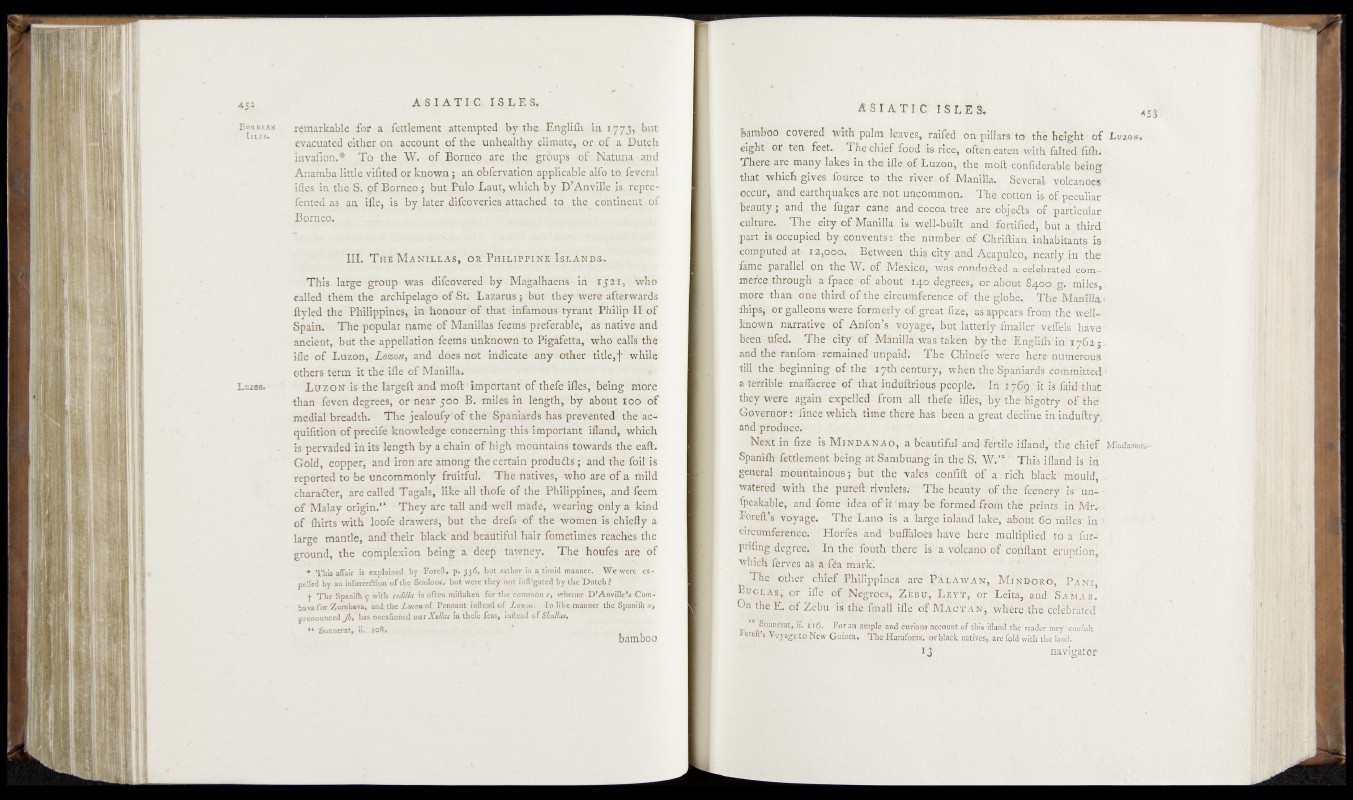
Borsean remarkable for a , fettlement attempted by the Englifh in 1773, but
evacuated either, on account of. the unhealthy climate, or oj; .a .Dutch
invafion.* To the W. of Borneo are the groups of Natuna and
Anamba littleyilited or known; an obfervation applicable alfo to feveral
Ifles in the S. of Borneo; but Pülo Laut, which by D’Anvillejs repre-
fented as. an ifle, is .'by later difeoveries attached to the continent of
Borneo,
I I I , T h é M a n i l l a s , o r P h i l i p f i 'n e T&l a n d s .
This large group was difeovered by Magalhaens- in i '5 2 ‘I , who
called them the archipelago o f St. Lazarus ; but they were afterwards
ftyled the Philippines, in honour o f that infamous tyrant Philip IlSof
Spain* The popular name of Manillas feems preferable, as native; and
ancient, but the appellation feems unknown to Pigafetta, who calls the
ifle o f Luzon, Lossan, and does not indicate anyxother. tid e,f awhile;
others term it the ifle of Manillas ■
L uz«r. L u zo n is the largeft and mod iifiportanf o f thefe ifles, being-more
than feven degrees, or near 500 B. miles-in length, *bsf, about lb o ' o f
medial breadth. The jealoufy of the Spaniards has prevented the’ac-
quilxtion of precife knowledge concerning this important ifland, whieh
- is pervaded in its length by a chain ó f high mountains towards the eaft.
Gold, copper* and iron are among the certain piódüS^^ and' the'JbfHs
reported to be uncommonly fruitful. The natives,- who are of a toil'd
character, are called Tagals, like all thofe of the Philippines, and fèèm
o f Malay origin.“ They are tall and^well made, wearing only a kind
o f fhirts with loofe drawers, but the drefs Of the women is chiefly a
large mantle, and their black and beautiful hair fometimes reaches the
ground, the complexion being a deep tawney. The houfes are of
* This affair is explained by-Foreft, p; ^36, but rather in atimid manner. We were expelled
by an irifurreéfion of the SoolooS,' but were they not' inft’gated by the Dutch ? "
- + The Spanifh c with cedilla is often miftaken for the common c, whence,1 D’Anville’s Cum-
- bavafor Zumbava, and the Lucon of Pennant inftead of Luzon* In litre manner the Spanilh x,
pronounced has oecafioned our Xvllas in thefc feas, inftead of Shullas.
** gonnerat, ii.' 108. bamboo
bamboo covered with palm fleaves, railed on pillars to the height ■ o f Luzon. -
eight' or .tea .feet. T h e f l s , r i s e , ■ Qfte'n-éat^n.with failed ■ fi (h>-
There.are many lakes itv thgsifle!of Luifeg|{|jU „tnafh.cpu.flderahle being
that wjaich gives fgifl;q«£, to.,'the .river ,o f M a n | ^ / ^ © i c a n o e y
occur, Jaijd,earthquakes* are i#Luncommohv." Tfle cMon,i^«C-peculiar'
beauty; and the^fugar cane a-ijWób^|^of.particukr'
culture., .Th e eity of Manilla is w^ll-h^ilt ap^fl|ó^fled^but a third'
part isoceupièjd by o o n v e i^ j j ie numbe^-of inhcibitants is
computed at- ï Betweerp th^.-e|t^'tand.' j^^apulfokne^V-ly in thelame
parallef pn the Wl ó f i f e ^ ^ k ^ c o n ^ q o i j a *
mefce'BhrougHm lpace'‘®£*about’ i^ d e g F h e s l^ a h o u t Sijh^g^miles,, ‘
more thaju .ófte third of tbs' «reumferenCe of tihe.glllh^^-The Manilla-*
lhipSj <0^ galleons wer%forn^^y^grSa^'e,l~as^ppears.frëin,i^e well-'
known narrative of Anfm’s;ïVo^er.te^fla^m^H^lértv|flèh haver
heen' üfed. The city of Manilla^Was- taken by the- Englifh in 1762
and the ranform remained-unpaidï ' Thè-'Cfiïtiefe fte,re nutrierouê
tflf lhe beginning of the J 7èh century,’ Mfen-tfie SjpMxtèê dtohiïitfced I
a tex$ible maffaeiteO’ Of- that induftrk>nstp è t ) p f e In ij6 g it is faid that
they Were again expelled fromrall- thefe uflfes; b y ^he'^Bigöffy’^bMhd
Governors ^flnee which time there has bèeri-Pgrêat dBcffiiè iff illdüftry
and prod&ce.-
Next ih fize is M in d a n a o ; a beatitifuF'an<J^ërtAe‘iéMUy*tli^c!ii^ 'Mikmak-
Spanilh fettlement being at Sambnang in this S.' * Th& iflaiidts ih
general mountainous; but The ;ValdF eótflïft of- avrich black * 'mould,
watered with the putefl'rivulets;1^' T h t Kfeanty of tfte^f&Wery’ fe^tuU-
fpC##|l%'and feme idea o f i t ’may be formed" from thè
Föreft’s’-Voyage. The Land- is a ‘large1 inlahöFkkê; kböhtlSl iMës'-in <
circumference; Hoifés and buffaloes have here multiplied to a fur- '
prifing degree. ■ In the fouth there is a volcano of cbplliaht ‘ eruptidïi^ .
which ferves as'a fea mark'.
The other chief Philippines are P a l a w a n , 'P a n i ‘',
Buglas, or’ ifle o f Negroes, Z e b u , L e y t , or Leita, and Sam a r . •
On the E. o f Zebu is the fmall ifle of Ma cTAn , whère thé cëleÉrated" -
Sonnèrat, u. 116. For an ample and coriousi account ó f tkistiflk-nd thè reader may confult : -
roreft’s Voyage to New Guinea. The Haraforas'; or'blaék natives,, are fold'with the land.
-. 13' I navigator ■